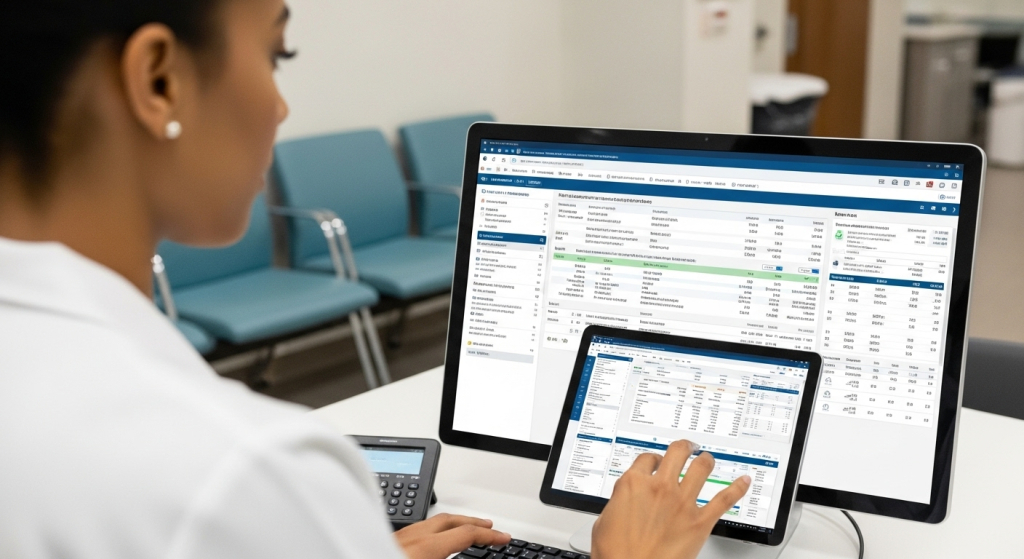You wouldn’t use a cargo ship to navigate a narrow river, nor would you attempt an ocean crossing in a speedboat. The tool must fit the task, a principle that holds especially true in the high-stakes world of health information technology. An Electronic Health Record (EHR) is the central nervous system of a modern healthcare organization. It dictates clinical workflows, manages the entire revenue cycle, facilitates communication, and serves as the legal record of patient care. In this critical space, two names often dominate the conversation, representing vastly different philosophies, technologies, and business models: eClinicalWorks and Epic.
That brings us to the core conflict. We have two titans of the EHR world, often mentioned in the same breath, yet they are champions of fundamentally different domains. eClinicalWorks has methodically built its empire by serving the agile, budget-conscious, and fiercely independent private practice. Epic Systems, conversely, stands as the undisputed heavyweight champion for large, complex, integrated health systems and academic medical centers.

Framing the eClinicalWorks vs Epic debate as a simple head-to-head competition for the same prize misses the entire point. They are not always direct competitors; they are apex predators thriving in separate, distinct ecosystems. The very attributes that make one an ideal partner for a five-physician primary care clinic are the same reasons it would struggle to meet the intricate demands of a 20-hospital integrated delivery network (IDN). The choice of an EHR is a 10- to 15-year strategic commitment, a partnership that will profoundly shape an organization’s future.
This article will provide a definitive showdown of eClinicalWorks vs Epic, but not on a single, generic battlefield. Instead, we will dissect their strengths, weaknesses, philosophies, and functionalities within two specific arenas of comparison. By understanding the context behind the technology, healthcare leaders can move beyond brand names and make informed, strategic decisions that align with their organization’s most critical and enduring needs.
Is your EHR integration project stalled by data silos and interoperability roadblocks? Don’t let tech complexity compromise patient care. SPsoft brings years of focused experience in navigating health data technology!
The Private Practice Arena: Agility and Affordability
For the practice manager or physician-owner of a small to medium-sized private practice, the world of healthcare is defined by a delicate balance of clinical autonomy and business pragmatism. Decisions are not made by committees in boardrooms but by the very people delivering care and managing the front desk.

In this environment, the EHR is the most critical technology investment, and a set of uncompromising realities governs its selection: budgets are tight, dedicated IT resources are a luxury, and administrative efficiency is the lifeblood of financial survival. In this arena, the eClinicalWorks vs Epic comparison is less of a spirited debate and more of a clear-cut decision rooted in accessibility, affordability, and fundamental design philosophy.
Total Cost of Ownership & Pricing Models
The single greatest barrier between a private practice and an EHR platform is, and always will be, cost. It’s not just the sticker price, but the total cost of ownership (TCO) over five to ten years that truly matters. That is where the two vendors inhabit different financial universes.
eClinicalWorks
The eClinicalWorks model is specifically designed for private practice budgets. It almost exclusively operates on a Software-as-a-Service (SaaS) model. That means the software is hosted on eClinicalWorks’ servers (in the cloud) and accessed by the practice via the internet for a recurring subscription fee. The typical pricing structure is a per-provider-per-month (PPPM) fee, which, as of recent estimates, often ranges from $449 for the basic EHR to $599 for the EHR with integrated Practice Management (PM).
This subscription model is profoundly advantageous for a private practice:
- Predictable Operational Expense: It turns a potentially crippling capital expenditure into a predictable monthly line item in the operational budget. That makes financial planning straightforward.
- Low Barrier to Entry: The upfront investment is comparatively minimal. Practices will face costs for data migration from a previous system and for initial implementation and training, but these are typically in the thousands or tens of thousands, not millions.
- No Infrastructure Burden: This is a critical, often underestimated benefit. The clinic does not need to buy, secure, cool, power, or maintain its physical servers. The cost and complexity of server refreshes, data backups, and HIPAA-compliant server security are all offloaded to the vendor.
Epic
In contrast, Epic is almost entirely inaccessible to the small and medium private practice market. Its cost structure and business model are designed for the multi-billion-dollar health system. The TCO for an Epic implementation is staggering, often starting in the tens of millions for smaller hospitals and soaring to over $1 billion for large IDNs. The components of this cost include:
- Massive Upfront Licensing Fees: A significant, multi-million-dollar capital investment to acquire the rights to use the software.
- On-Premise Infrastructure: Epic is traditionally self-hosted. That means the health system must build, staff, and maintain its own Tier III or Tier IV data centers—a multi-million dollar venture in itself—with robust servers, storage arrays, and networking infrastructure capable of handling immense data loads with high availability.
- Armies of Certified Staff: A health system can’t just buy Epic; it must hire or train a small army of expensive, certified analysts to build, maintain, and customize the system. These specialized salaries are a permanent addition to the payroll.
The financial chasm is not just a gap; it’s a canyon. The table below illustrates this fundamental difference in financial philosophy.
| Cost Component | eClinicalWorks (For Private Practice) | Epic (For Large Health System) |
|---|---|---|
| Pricing Model | Subscription (SaaS) | Perpetual License + Annual Maintenance |
| Typical Cost | ~$500 / provider / month | $40 Million – $2 Billion+ (Total Project) |
| Upfront Investment | Low (Implementation & Training Fees) | Extremely High (Licensing, Hardware) |
| Hosting | Cloud-Based (Vendor-Managed) | Self-Hosted (On-Premise Data Centers) |
| Budget Type | Operational Expense (OpEx) | Capital Expenditure (CapEx) |
| Internal Staffing | Uses existing staff; no new hires required. | Requires dedicated teams of certified analysts. |
For a private practice, the eClinicalWorks cost model represents a sustainable partnership, while the cost of Epic represents an insurmountable barrier.
Implementation, Training, and Ease of Use
After cost, the implementation journey—the timeline, resource drain, and complexity—is the next primary consideration.
eClinicalWorks:
One of the core value propositions of eClinicalWorks for a smaller clinic is its relatively rapid, templated implementation. A typical journey for a 5-provider practice might look like this:
- Kickoff & Planning (Weeks 1-2): The practice is assigned an implementation specialist. They review the practice’s current workflows, select pre-built templates tailored to their specialty, and develop a data migration plan.
- System Build & Training (Weeks 3-8): The implementation specialist configures the system based on the practice’s needs. Key staff members (e.g., the office manager, lead MA) undergo “train the trainer” sessions, and then all staff complete online and on-site training modules.
- Go-Live (1-2 Days): The switch is flipped. The implementation specialist is typically on-site to provide hands-on support, troubleshoot issues, and ensure a smooth transition. Patient schedules are often lightened for the first few days.
- Post-Go-Live Support (Ongoing): The practice transitions to the standard help desk and ticketing system for ongoing support.
Regarding ease of use, the eClinicalWorks interface is famously feature-dense. For some, its “cockpit” design, which puts a massive amount of information on one screen, is highly efficient. For others, it can feel cluttered and overwhelming. However, it is highly configurable, allowing users to create custom workflows and templates to streamline their personal use over time.
Epic:
An Epic implementation is a multi-year odyssey that fundamentally reshapes the entire health system. The process is meticulous and resource-intensive, involving a ground-up rebuild of every clinical and administrative process. It requires the health system to dedicate dozens, if not hundreds, of its staff—nurses, pharmacists, physicians, billers—to work full-time on the project for its duration. The learning curve is notoriously steep, requiring weeks of mandatory, role-based classroom training for every single employee before they can gain access.
The sheer scale of this undertaking is beyond the capacity of any independent private practice. The Epic vs eClinicalWorks debate on implementation is a contest between a weekend project and building a skyscraper.
Key Features & Support for Small Practices
Private practices don’t just need a digital chart; they need a unified command center for their entire business. An EHR for private practice must expertly integrate clinical documentation with financial management tools.
eClinicalWorks excels in this regard by offering a tightly integrated, all-in-one solution designed to maximize revenue and efficiency for small practices.
- Integrated Practice Management (PM): The seamless link between the clinical chart and the scheduling/billing engine is core to eClinicalWorks. An appointment is scheduled, insurance eligibility is automatically checked, the clinician documents the visit, a superbill is generated from the documentation, and a claim is created, all within a single system.
- Revenue Cycle Management (RCM) Services: This is a crucial lifeline. Many practices opt for eClinicalWorks’ RCM service, effectively outsourcing their billing department. For a percentage of collections (typically 3-7%), eClinicalWorks’ teams will manage claim scrubbing and submission, work denials from payers, post payments, and handle patient statement processing. That allows physicians to focus on medicine, not on chasing insurance payments.
- Patient Engagement (healow): The healow (Health and Online Wellness) app is a surprisingly robust suite for patient engagement. It provides a secure patient portal, integrated telehealth visits, automated appointment reminders, and even specific apps like Healow Mom and Healow Kids for specialty care. That provides small practices with an enterprise-grade digital front door, enabling them to compete with larger systems.
Support for eClinicalWorks is typically handled through a centralized, tiered system of online tickets and call centers. While this model is efficient for serving a high volume of clients, it can sometimes be a source of frustration for users who require immediate, personalized attention for complex issues.
Verdict for Private Practices
For the overwhelming majority of small to medium-sized private practices, the eClinicalWorks vs Epic showdown has a clear and decisive winner. The prohibitive cost, monumental implementation scope, and heavy resource requirements of Epic place it in a completely different stratosphere. eClinicalWorks, with its affordable and predictable subscription model, its all-in-one feature set including critical RCM services, and its manageable implementation process, is purpose-built for the private practice environment. It delivers the essential tools for clinical documentation, practice management, and revenue cycle health in a package that is both financially viable and logistically feasible for an independent clinic.
The Large Health System Battleground: Scale, Power, and Integration
When the conversation shifts from the independent clinic to the sprawling campus of a large hospital, an academic medical center, or a multi-state Integrated Delivery Network (IDN), the criteria for a superior EHR change completely. Andrii Senyk, the Vice President of SPsoft, indicates:
“The primary concerns pivot from monthly affordability to immense power, from all-in-one simplicity to deep, specialized customization, and from basic connectivity to profound, enterprise-wide EHR interoperability. In this arena, the eClinicalWorks vs Epic dynamic completely inverts, and the cargo ship shows its true strength.”

Scalability, Customization, and Performance
This is Epic’s home turf. Its entire architecture and corporate philosophy are engineered for the specific, high-stakes challenges of the massive healthcare enterprise.
Epic:
The defining characteristic of Epic is its immense scalability in EHRs. The platform is architected around a single, unified database model called Chronicles. That means every piece of data for every patient—clinical notes, lab results, prescriptions, billing information, scheduling—resides in one integrated database. The SPsoft’s CEO, Mike Lazor, claims:
“This architecture is fundamental to its ability to serve as the single source of truth for millions of patient records, supporting tens of thousands of concurrent users across hundreds of facilities without compromising performance. For an EHR for large health systems, this level of performance at scale is a non-negotiable, foundational requirement.”
Furthermore, Epic’s legendary power lies in its deep, granular customization. Large health systems are not monolithic; they are a complex collection of highly specialized departments. The workflows for a Level I trauma center differ significantly from those of a transplant surgery department or a community oncology clinic.
Epic allows (and requires) health systems to build out these highly specialized workflows, decision support rules, order sets, and documentation templates directly into the EHR’s foundation. For example, a system could build a multi-stage chemotherapy protocol in the Beacon oncology module with dozens of built-in safety checks that automatically verify lab parameters and calculate weight-based dosing, preventing potentially fatal errors. That requires a significant and permanent investment in certified analysts, but the result is a bespoke system meticulously tailored to the organization’s unique operational and clinical DNA.
eClinicalWorks
While eClinicalWorks serves some larger ambulatory groups quite effectively (e.g., 100-200 provider networks), it was not fundamentally designed for the scale and, more importantly, the complexity of a large IDN with significant inpatient operations. Its architecture, while robust for the private practice world, would face significant performance and data model challenges when tasked with managing the torrent of data and intricate, interdependent workflows of a major hospital. Its customization is more about configuration and templating, not the foundational-level engineering that Epic provides.
Interoperability and Data Exchange
For an extensive health system, which often serves as a regional or national healthcare hub, the ability to exchange data with other organizations fluidly and seamlessly is mission-critical for patient safety and care coordination.

Epic
Epic’s greatest strategic advantage and market-defining feature is its Care Everywhere network. Because of Epic’s dominant market share among large health systems, this interoperability platform has become the de facto data-sharing highway for American healthcare. From within a patient’s chart, a clinician can, with a single click, query and retrieve a comprehensive summary of that patient’s records from any other Epic-using institution in the country.
A patient from Chicago showing up in a Los Angeles ER can have their complete problem list, medication history, and allergies instantly available to the treating physician. Beyond this, Epic’s “Share Everywhere” feature enables patients to grant any provider with an internet connection—even non-Epic users—temporary, secure access to their MyChart record. Epic also plays a leading role and integrates deeply with national interoperability frameworks, such as Carequality and the CommonWell Health Alliance.
eClinicalWorks
eClinicalWorks certainly has robust interoperability features. It is ONC-certified and connects to the same national networks like Carequality and CommonWell, allowing its users to exchange data with a wide variety of other EHRs. However, it does not possess a proprietary, single-vendor network with the same ubiquitous reach and one-click simplicity as Care Everywhere. For an extensive health system that coordinates complex Care with numerous other major hospitals and specialty centers, the high probability that those partners are also on Epic makes the native Care Everywhere connection a decisive, built-in advantage that is difficult for other vendors to replicate.
Specialty Modules, Analytics, and Research
Large academic medical centers and integrated health systems have needs that go far beyond standard ambulatory charting. They require deeply specialized, best-in-class tools for complex inpatient and ancillary departments, as well as robust data analytics for population health, operations management, and clinical research.
That is a key differentiator in the Epic vs eClinicalWorks comparison for a large enterprise. Epic offers a comprehensive, tightly integrated suite of specialty modules that are widely considered the gold standard. A key value proposition is their seamless integration into a single database.
Consider the following workflow: A cardiologist documents a finding in Cupid (the cardiology module) and orders a new medication. That order flows instantly to Willow (pharmacy module), which automatically flags a potential interaction with a recent creatinine value from Beaker (lab module). The alert is routed to the pharmacist’s inbox and the physician’s In Basket simultaneously. This closed-loop system of communication and safety checks across departments is a core strength.
| Epic Module | Primary Function / Department |
| ASAP | Emergency Department Information System (EDIS) |
| OpTime | Operating Room & Anesthesia Management |
| Willow | Inpatient and Outpatient Pharmacy System |
| Beaker | Laboratory Information System (LIS) |
| Radiant | Radiology Information System (RIS) |
| Beacon | Medical Oncology Module |
| Stork | Obstetrics & Labor and Delivery |
| Cupid | Cardiology Information System |
Furthermore, Epic’s analytics platform, Cogito, offers a comprehensive suite of tools for transforming raw data into actionable insights. It includes a massive data warehouse and self-service tools like “SlicerDicer,” which allows non-technical clinicians or department heads to visually explore patient population data, identify trends, and drill down into specific cohorts without needing a programmer.
This capability is foundational for supporting clinical research, quality improvement initiatives, and population health management at academic medical centers. eClinicalWorks’ analytics are more than adequate for managing a private practice’s patient panel, but they lack the sophisticated data warehousing and research-grade capabilities of Epic’s Cogito platform.
Verdict for Large Health Systems
For the extensive, complex health system, the verdict is as clear as it was for private practice, but in the opposite direction. The non-negotiable requirements for massive EHR scalability, deep workflow and clinical content customization, seamless enterprise interoperability via Care Everywhere, and a comprehensive suite of integrated specialty modules make Epic the dominant force and the de facto choice. The multi-year, multi-million-dollar investment required for an Epic implementation is justified by the platform’s unparalleled ability to serve as the digital backbone for a modern, multi-faceted, high-volume healthcare enterprise. In this battleground, the Epic vs eClinicalWorks debate concludes with Epic as the clear champion.
Head-to-Head Comparison on Key Battlefields
While the two platforms are built for different worlds, a direct feature comparison helps understand their relative strengths. The following scorecard summarizes the key differences for decision-makers across a range of essential attributes.
eClinicalWorks vs. Epic: The Ultimate Scorecard
| Feature/Attribute | eClinicalWorks | Epic |
|---|---|---|
| Target Market | Winner: Private Practices (1-50 Providers) | Winner: Large Health Systems & IDNs |
| Typical Cost | Low (Predictable Monthly Subscription) | Extremely High (Massive Capital Investment) |
| Implementation | Fast (Weeks to Months) | Very Slow (18-24+ Months) |
| Scalability | Good for ambulatory; limited for enterprise. | Near-limitless for enterprise health. |
| Interoperability | Good (Connects to national networks) | Excellent (Dominant Care Everywhere network) |
| Customization | Standard (Configuration & Templating) | Deep (Ground-up workflow engineering) |
| Patient Portal | healow: Feature-rich & well-integrated. | MyChart: Industry standard, high patient adoption. |
| AI Roadmap | Strong focus on AI for documentation to reduce “pajama time.” | Strong focus on ambient AI & predictive analytics within workflows. |
Elaborating on these points, the patient portal comparison highlights different strategic goals. MyChart offers a consistent and trusted brand experience for patients across all facilities of a health system. Healow, for its part, provides an independent practice with a powerful, modern digital toolset that enables it to offer the same conveniences as its larger competitors. In telehealth, both offer integrated solutions, but eClinicalWorks’ native telehealth is often seen as more nimble and easier for a small practice to deploy quickly.
In the race for AI, both vendors are aggressively pursuing the holy grail of reduced administrative burden. eClinicalWorks is focusing on utilizing generative AI to transcribe patient conversations and automatically draft clinical notes, thereby combating physician burnout. Epic is embedding similar ambient listening tools and predictive analytics deeply into its enterprise platform, enabling features like real-time sepsis risk prediction based on incoming data streams.
Final Thoughts
The intense debate between eClinicalWorks and Epic often creates more heat than light because it fundamentally asks the wrong question. The question is not “Which EHR is better?” but “Which EHR is right for my organization, right now, and for the next ten years?” As we have dissected across two distinct arenas, there is no single winner, only a winner for a specific context. The cargo ship and the speedboat are both exceptional vessels, but their value is entirely dependent on the body of water they are meant to navigate.
To summarize the two showdowns:
- For the agile private practice, where budgets are finite, IT resources are lean, and all-in-one business efficiency is king, eClinicalWorks is the logical and resounding victor. Its predictable cost, rapid implementation, and integrated practice management and RCM services are purpose-built for this demanding environment.
- For the large, complex health system, where immense scalability, deep specialization, robust research capabilities, and enterprise-wide interoperability are paramount, Epic stands as the undisputed champion. Its platform is the digital bedrock upon which a modern, integrated delivery network can be built, managed, and grown.
Ultimately, the most critical step in the EHR selection process precedes any vendor demonstration. It begins with a deep and honest assessment of your own organization’s scale, budget, strategic goals, and human resources. More importantly, it requires a “future-state” analysis. Where do you envision your organization being in five or ten years? Are you planning to remain independent? Acquire other local practices? Expand into new service lines like specialty care or surgery? Be acquired by a larger system? The answer to these strategic questions will point you toward the right EHR partner. The choice is not merely about software features; it is a long-term strategic partnership. It is about aligning your organization with a platform, a philosophy, and a partner that was fundamentally built for your world.
Your EHR is the heart of your organization, but its true power is only unleashed when it’s seamlessly connected to the entire digital health ecosystem. SPsoft is your strategic partner in building a scalable, secure, and future-proof foundation for tomorrow’s healthcare!
FAQ
Why can’t my private practice buy a license for Epic?
Epic’s platform is not designed or priced for private practices. The total cost involves far more than software licensing; it requires multi-million dollar investments in on-premise data centers, a permanent staff of certified analysts, and a multi-year implementation project. The entire business model is designed for large, complex health systems with substantial capital budgets and extensive IT resources. For private practices, eClinicalWorks’ affordable, cloud-based subscription model is the financially viable and logistically manageable choice.
My practice is growing fast. Will I eventually outgrow eClinicalWorks?
That depends on your growth trajectory. eClinicalWorks is highly scalable for ambulatory settings and can comfortably support practices growing from a few providers to large, multi-specialty groups of over 100 physicians. However, if your growth involves acquiring or building hospitals with complex inpatient and surgical workflows, you would then enter the territory where a system like Epic becomes necessary. Even for the most aggressive ambulatory growth, eClinicalWorks remains a robust and suitable solution.
MyChart vs. Healow: Which patient portal is better?
“Better” depends on the goal. Epic’s MyChart is the industry standard for large health systems, offering a consistent, trusted brand experience that millions of patients already know and use. For a hospital, this widespread familiarity is a major asset. eClinicalWorks’ healow app is highly competitive in terms of features, offering telehealth, reminders, and remote monitoring, and provides independent practices with a powerful, enterprise-grade tool to enhance patient engagement without the enterprise price tag, allowing them to offer modern digital conveniences.
How long does it take to “go live” on eClinicalWorks vs. Epic?
The timelines are worlds apart. A small to medium-sized practice can typically implement and go live on eClinicalWorks within a few months. The process is templated and guided by an implementation specialist. In stark contrast, implementing Epic for a hospital or health system is a monumental undertaking, lasting 18 to 24 months (or longer). It involves a fundamental re-engineering of all clinical and administrative workflows, requiring dedicated internal teams and extensive, mandatory training for every employee.
Many hospitals in my area use Epic. Will my practice’s eClinicalWorks be able to connect?
Yes. While it’s not a native Epic-to-Epic connection, eClinicalWorks is fully certified and connects to national interoperability frameworks, such as Carequality and CommonWell. That means you can electronically exchange patient summaries, lab results, and other critical data with any other connected system, including Epic. While Epic’s proprietary Care Everywhere network may be more seamless between its users, eClinicalWorks ensures you can meet the modern standards for essential data exchange with your hospital partners.
What is the real Total Cost of Ownership (TCO)? Is a subscription truly cheaper?
For a private practice, yes, the TCO of a subscription model like eClinicalWorks is dramatically lower. The predictable monthly fee covers software, hosting, support, and maintenance, eliminating surprise costs. Epic’s TCO for a health system includes the massive initial license, plus the ongoing, multi-million-dollar operational costs of maintaining data centers, paying a team of specialized IT analysts, and funding continuous training and upgrades. The financial models are fundamentally different and built for vastly different scales.
Which EHR is more “future-proof” when it comes to Artificial Intelligence?
Both vendors are aggressively pursuing AI, but with a focus that mirrors their target markets. Epic is leveraging its vast data repositories to build predictive analytics for disease and integrate ambient listening tools directly into complex hospital workflows. eClinicalWorks is heavily focused on utilizing AI to enhance efficiency for private practices, such as automatically generating clinical notes from conversations, thereby reducing physician burnout and “pajama time.” Both are future-proof, but they are building for different futures.



